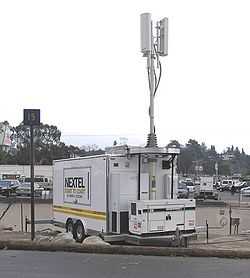Cell on wheels

A cell on wheels, usually referred to as a COW, is a mobile cell site that consists of a cellular antenna tower and electronic radio transceiver equipment on a truck or trailer, designed to be part of a cellular network.[1]
Expanded or emergency service
COWs are used to provide expanded cellular network coverage and/or capacity at special events such as major sporting events (Super Bowl, World Series, Rose Bowl), major conventions, or in disaster areas where cellular coverage either was never present (e.g., in a wilderness area where firefighters have set up a command center during a major forest fire) or was compromised by the disaster (e.g., in the Gulf Coast after Hurricane Katrina). Following the September 11 attacks on New York City in 2001, 36 cellular COWs were deployed by September 14, 2001 in Lower Manhattan to support the U.S. Federal Emergency Management Agency (FEMA) and provide critical phone service to rescue and recovery workers. COWs provided cellular service in Southwest Florida the aftermath of Hurricane Charley in 2004 with most of the area's stationary cell towers destroyed.[2] In January 2009, 26 cell-on-wheels units were put in place in Washington, D.C. for the inauguration of Barack Obama to handle the millions of extra people and their calls in the city, especially on and near the National Mall.
Many telecommunications companies also use COWs for long-term placement when financing or infrastructure considerations prevent building a permanent site at the location. For instance, a carrier may have approved the placement of a cell site for coverage reasons, but the remaining budget is inadequate to fund the construction for a fiscal quarter or even longer. An engineering team may be able to place a COW on location to provide immediate coverage with few costs other than leasing, electricity, and backhaul. The decision to use a COW for an extended period of time may also be driven by the property owner. Installations on government or military facilities may be granted only on a temporary basis, and may require the use of non-permanent facilities.
A COW may also be referred to as a site on wheels (SOW). Not all portable communication centers are created equally. Many are nothing more than a cargo trailer or box that has been modified to hold communication equipment and have an antenna tower. Tower types vary from one manufacturer to another; guyed vs. unguyed, methods of deploying the tower, whether it meets TIA/EIA specifications. Many COWs do not protect their sensitive equipment from the effects of lightning or power surges. The backhaul to the network can be via terrestrial microwave, communication satellite, or existing wired infrastructure.

Cell in a box (CIAB)
Related to a COW is a CIAB (cell in a box). Like COWs, CIABs provide temporary service with temporary equipment. The main difference is that a CIAB is typically placed for a longer period of time than a COW.
Cell on Light Trucks (COLTs)
COLTs are on smaller box trucks and are limited with respect to the cell phone network, as opposed to the fully functional COW.[3]
See also
References
- ↑ New York Times, "Inauguration Crowd Will Test Cellphone Networks", URL retrieved 19 January 2009.
- ↑ http://www.operationgadget.com/2004/08/mobile_carriers.html
- ↑ , Verizon Wireless Network specifications, Retrieved on January 28, 2010.